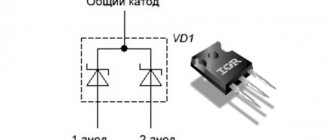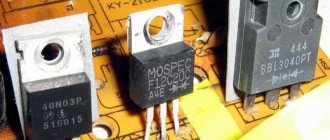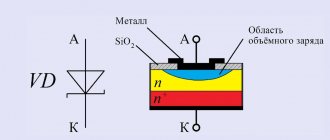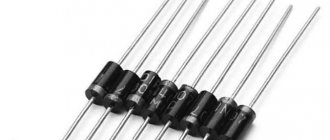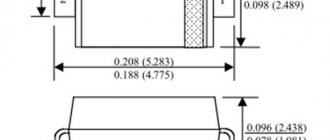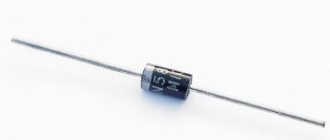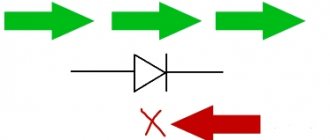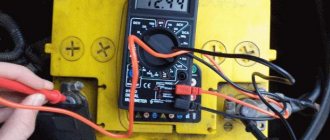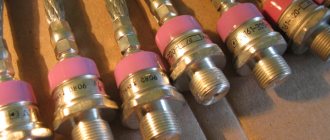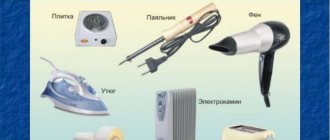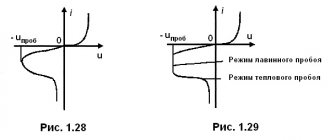Designation, application and parameters of Schottky diodes
To the large family of semiconductor diodes named after the names of the scientists who discovered the unusual effect, we can add one more.
This is a Schottky diode. German physicist Walter Schottka discovered and studied the so-called barrier effect that occurs with a certain technology for creating a metal-semiconductor transition.
The main feature of a Schottky diode is that, unlike conventional diodes based on a pn junction, it uses a metal-semiconductor junction, which is also called a Schottky barrier. This barrier, just like the semiconductor pn junction, has the property of one-way electrical conductivity and a number of distinctive properties.
The materials used to make Schottky barrier diodes are predominantly silicon (Si) and gallium arsenide (GaAs), as well as metals such as gold, silver, platinum, palladium and tungsten.
In circuit diagrams, a Schottky diode is depicted like this.
As you can see, its image is somewhat different from the designation of a conventional semiconductor diode.
In addition to this designation, in the diagrams you can also find an image of a dual Schottky diode (assembly).
A dual diode is two diodes mounted in one common housing. The terminals of their cathodes or anodes are combined. Therefore, such an assembly, as a rule, has three outputs. Switching power supplies usually use common cathode assemblies.
Since two diodes are placed in the same housing and made in a single technological process, their parameters are very close. Since they are placed in a single housing, their temperature conditions are the same. This increases the reliability and service life of the element.
Schottky diodes have two positive qualities: a very low forward voltage drop (0.2-0.4 volts) across the junction and very high performance.
Unfortunately, such a small voltage drop occurs when the applied voltage is no more than 50-60 volts. As it increases further, the Schottky diode behaves like a regular silicon rectifier diode. The maximum reverse voltage for Schottky usually does not exceed 250 volts, although on sale you can find samples rated at 1.2 kilovolts (VS-10ETS12-M3).
Thus, the dual Schottky diode (Schottky rectifier) 60CPQ150 is designed for a maximum reverse voltage of 150V, and each of the diodes in the assembly is capable of passing 30 amperes in direct connection!
You can also find samples whose half-cycle rectified current can reach a maximum of 400A! An example is the VS-400CNQ045 model.
Very often, in circuit diagrams, the complex graphical representation of the cathode is simply omitted and the Schottky diode is depicted as a regular diode. And the type of element used is indicated in the specification.
The disadvantages of diodes with a Schottky barrier include the fact that even if the reverse voltage is briefly exceeded, they instantly fail and, most importantly, irreversibly. While silicon power valves, after the excess voltage stops, are perfectly self-healing and continue to work. In addition, the reverse current of diodes very much depends on the junction temperature. At a large reverse current, thermal breakdown occurs.
In addition to high speed and, therefore, short recovery time, the positive qualities of Schottky diodes include a small junction (barrier) capacitance, which allows you to increase the operating frequency. This allows them to be used in pulse rectifiers at frequencies of hundreds of kilohertz. A lot of Schottky diodes find their application in integrated microelectronics. Schottky diodes made using nanotechnology are included in integrated circuits, where they bypass transistor junctions to improve performance.
Schottky diodes of the 1N581x series (1N5817, 1N5818, 1N5819) have taken root in amateur radio practice. All of them are designed for a maximum forward current ( IF(AV) ) of 1 ampere and a reverse voltage ( VRRM ) of 20 to 40 volts. The voltage drop ( VF ) across the junction is 0.45 to 0.55 volts. As already mentioned, the forward voltage drop of diodes with a Schottky barrier is very small.
Another fairly well-known element is 1N5822. It is designed for a forward current of 3 amperes and is housed in a DO-201AD housing.
Also on printed circuit boards you can find diodes of the SK12 - SK16 series for surface mounting. They are quite small in size. Despite this, SK12-SK16 can withstand forward current up to 1 ampere at a reverse voltage of 20 - 60 volts. The forward voltage drop is 0.55 volts (for SK12, SK13, SK14) and 0.7 volts (for SK15, SK16). Also in practice you can find diodes of the SK32 - SK310 series, for example, SK36 , which is designed for a forward current of 3 amperes.
Application of Schottky diodes in power supplies.
Schottky diodes are actively used in computer power supplies and switching voltage stabilizers. Among the low-voltage supply voltages, the highest current (tens of amperes) are +3.3 volts and +5.0 volts. It is in these secondary power supplies that Schottky barrier diodes are used. Most often, three-terminal assemblies with a common cathode are used. It is the use of assemblies that can be considered a sign of a high-quality and technologically advanced power supply.
Failure of Schottky diodes is one of the most common faults in switching power supplies. It can have two “dead” states: pure electrical breakdown and leakage. If one of these conditions is present, the computer's power supply is blocked as the protection is triggered. But this can happen in different ways.
In the first case, all secondary stresses are absent. The protection has blocked the power supply. In the second case, the fan “twitches” and voltage ripples periodically appear and then disappear at the output of the power supplies.
That is, the protection circuit is periodically triggered, but the power source is not completely blocked. Schottky diodes are guaranteed to fail if the radiator on which they are installed is very hot until an unpleasant odor appears. And the last diagnostic option is related to a leak: when the load on the central processor increases in multiprogram mode, the power supply turns off spontaneously.
It should be borne in mind that when professionally repairing a power supply, after replacing secondary diodes, especially with a suspected leak, you should check all power transistors that perform the function of keys and vice versa: after replacing key transistors, checking secondary diodes is a mandatory procedure. It is always necessary to be guided by the principle: trouble does not come alone.
Checking Schottky diodes with a multimeter.
You can check the Schottky diode using a commercial multimeter. The technique is the same as when checking a conventional semiconductor diode with a pn junction. But there are pitfalls here too. A leaky diode is especially difficult to test. First of all, the element must be removed from the circuit for a more accurate check. It is quite easy to determine a completely broken diode. At all limits of resistance measurement, the faulty element will have infinitesimal resistance, both in forward and reverse connection. This is equivalent to a short circuit.
It is more difficult to check a diode with a suspected “leakage”. If we check with a DT-830 multimeter in the “diode” mode, we will see a completely serviceable element. You can try measuring its reverse resistance using an ohmmeter. At the “20 kOhm” limit, the reverse resistance is defined as infinitely large. If the device shows at least some resistance, say 3 kOhm, then this diode should be considered suspicious and replaced with a known good one. A complete replacement of Schottky diodes on the +3.3V and +5.0V power buses can provide a 100% guarantee.
Where else are Schottky diodes used in electronics? They can be found in rather exotic devices, such as alpha and beta radiation receivers, neutron radiation detectors, and recently, solar panels have been assembled on Schottky barrier junctions. So, they also supply electricity to spacecraft.
Video
Firstly, if the maximum reverse voltage is briefly exceeded, the Schottky diode irreversibly fails, unlike silicon diodes, which go into reverse breakdown mode, and provided that the maximum power dissipated on the diode is not exceeded, after a voltage drop the diode completely restores its properties.
Secondly, Schottky diodes are characterized by increased (relative to conventional silicon diodes) reverse currents, which increase with increasing crystal temperature. For the above 30Q150, the reverse current at maximum reverse voltage varies from 0.12 mA at +25°C to 6.0 mA at +125°C. For low-voltage diodes in TO-220 packages, the reverse current can exceed hundreds of milliamps (MBR4015 - up to 600 mA at +125°C). Under unsatisfactory heat dissipation conditions, positive heat feedback in the Schottky diode leads to its catastrophic overheating.
The current-voltage characteristic of the Schottky barrier has a pronounced asymmetric appearance. In the forward bias region, the current increases exponentially with increasing applied voltage. In the reverse bias region, the current does not depend on the voltage. In both cases, with forward and reverse bias, the current in the Schottky barrier is due to the majority charge carriers - electrons. For this reason, diodes based on the Schottky barrier are fast-acting devices, since they lack recombination and diffusion processes. The asymmetry of the current-voltage characteristic of the Schottky barrier is typical for barrier structures. The dependence of current on voltage in such structures is due to a change in the number of carriers taking part in charge transfer processes. The role of external voltage is to change the number of electrons passing from one part of the barrier structure to another.
Schottky diodes in power supplies
In system power supplies, Schottky diodes are used to rectify the current of the +3.3V and +5V channels, and, as is known, the output currents of these channels amount to tens of amperes, which leads to the need to take very seriously the issues of rectifier performance and reducing their energy losses. Solving these issues can significantly increase the efficiency of power supplies and increase the reliability of the power transistors in the primary part of the power supply.
So, to reduce dynamic switching losses and eliminate short-circuit mode during switching, in the highest current channels (+3.3V and +5V), where these losses are most significant, Schottky diodes are used as rectifier elements. The use of Schottky diodes in these channels is due to the following considerations:
· The Schottky diode is an almost inertia-free device with a very short recovery time of reverse resistance, which leads to a decrease in the reverse secondary current and to a decrease in the surge current through the collectors of the power transistors of the primary part at the moment the diode switches. This significantly reduces the load on the power transistors, and, as a result, increases the reliability of the power supply.
· The forward voltage drop across the Shoki diode is also very small, which at a current value of 15-30 A provides a significant gain in efficiency.
Since in modern power supplies the +12V voltage channel also becomes very powerful, the use of Schottky diodes in this channel would also give a significant energy effect, but their use in the +12V channel is impractical. This is due to the fact that when the reverse voltage exceeds 50V (and in the +12V channel the reverse voltage can reach 60V), Schottky diodes begin to switch poorly (too long and at the same time significant reverse leakage currents arise), which leads to the loss of all advantages their applications. Therefore, high-speed silicon pulse diodes are used in the +12V channel. Although the industry now produces Schottky diodes with high reverse voltage, their use in power supplies is considered inappropriate for various reasons, including economic ones. But there are exceptions to any rule, so in individual power supplies you can find Schottky diode assemblies in +12V channels.
In modern system power supplies for computers, Schottky diodes are, as a rule, diode assemblies of two diodes (diode half-bridges), which clearly increases the manufacturability and compactness of power supplies, and also improves the cooling conditions of the diodes. The use of individual diodes rather than diode assemblies is now an indicator of a low-quality power supply.
Diode assemblies are produced mainly in three types of packages:
· TO-220 (less powerful assemblies with operating currents up to 20 A, sometimes up to 25-30 A);
· TO-247 (more powerful assemblies with operating currents of 30 - 40 A);
· TO-3P (powerful assemblies).
The electrical characteristics of diode assemblies most commonly used in modern system power supplies are presented in Table 1.
The interchangeability of diode assemblies is determined based on their characteristics. Naturally, if it is impossible to use a diode assembly with exactly the same characteristics, it is better to replace it with a device with higher current and voltage values. Otherwise, it will be impossible to guarantee stable operation of the power supply. There are cases when manufacturers use diode assemblies in their power supplies with a significant power reserve (although more often we observe the opposite situation), and during repairs it is possible to install a device with lower current or voltage values. However, with such a replacement, it is necessary to carefully analyze the characteristics of the power supply and its load, and all responsibility for the consequences of such modification, naturally, falls on the shoulders of the specialist performing the repair.
An element such as a Schottky diode
although it was invented quite a long time ago, it appeared in the everyday life of radio amateurs relatively recently and this was due to the fact that the Schottky diode has two very important and useful properties: firstly, a very high speed and secondly, a small forward voltage drop at the junction.
Previously, these two factors were not of particular importance, but in modern equipment operating at higher frequencies than before, the Schottky diode
is simply irreplaceable.
Let's look at the Schottky diode device
(also called
Schottky barrier diode
).
The most interesting thing about a Schottky diode is that it does not have a pn junction (!). Instead, a metal-semiconductor transition was made (see picture)
Designations in the figure: 1 - semiconductor substrate, 2 - epitaxial film; 3 - metal-semiconductor contact; 4 - metal film; 5 - external contact.
When an electric current passes through such a junction, excess electrons will be distributed over the near-contact region of the metal terminal, creating a kind of barrier (it was called the Schottky barrier) and due to this, rectifying properties are formed. Moreover, the height of the barrier can also be changed, thereby changing the properties of the diode.
Schottky diode designation on the diagram
In the diagrams, the Schottky diode is designated like this:
How to test a Schottky diode
As mentioned above, a Schottky diode has a low voltage drop across the junction: While conventional silicon diodes have a forward voltage drop of about 0.6-0.7V, germanium diodes have a forward voltage drop of about 0.4V, a Schottky diode has even less - about 0. 2V. And since the multimeter, when checking, shows nothing more than a voltage drop across the junction, the readings will be small: if when checking conventional diodes, the multimeter readings will be about 300...400 for germanium and 450...650 for silicon diodes, then when checking a Schottky diode, the multimeter will show 100…150.
Disadvantages of a Schottky diode
It seems that the Schottky diode is good for everyone: it works at HF currents and has no reverse capacitance and the voltage drop across it is minimal, but still, with all its charms, the Schottky diode also has disadvantages:
When the maximum reverse voltage is briefly exceeded, the Schottky diode irreversibly fails (short circuit - short circuit), unlike conventional silicon pn diodes, which go into a reversible breakdown mode, and, provided that the maximum power dissipated on the diode is not exceeded after a voltage drop, the diode is completely restores its properties.
Schottky diodes are characterized by increased (relative to conventional silicon pn diodes) reverse currents, which increase with increasing crystal temperature. For 30CPQ150, the reverse current at maximum reverse voltage varies from 0.12 mA at +25 °C to 6.0 mA at +125 °C. For low-voltage diodes in TO220 packages, the reverse current can exceed hundreds of milliamps (MBR4015 - up to 600 mA at +125 °C). Under unsatisfactory heat dissipation conditions, positive heat feedback in the Schottky diode leads to its catastrophic overheating.
What does a Schottky diode look like?
Yes, just like the most ordinary diode and you can identify it only by markings and by circuit designation
During the assembly of power supplies and voltage converters for car amplifiers, a problem often arises with rectifying the current from the transformer. Getting hold of powerful pulsed diodes is quite a serious problem, so I decided to publish an article that provides a complete list and parameters of powerful Schottky diodes. Some time ago, I personally had a problem with the converter rectifier for a car amplifier. The converter is quite powerful (500-600 watts), the output voltage frequency is 60 kHz, any common diode that can be found in old trash will immediately burn out like a match. The only available option at that time was the domestic KD213A. The diodes are quite good, they hold up to 10 Amps, the operating frequency is within 100 kHz, but they also overheated terribly under load.
In fact, powerful diodes can be found in almost everyone. A computer power supply is one that powers an entire computer. As a rule, they are made with a power from 200 watts to 1 kW or more, and since the computer is powered by direct current, this means that the power supply must have a rectifier. Modern power supplies use powerful Schottky diode assemblies to rectify the voltage - they have a minimal voltage drop across the transition and the ability to work in pulsed circuits, where the operating frequency is much higher than the network 50 Hz. Recently they brought several power supplies for free, from where the diodes were removed for this short review. In computer power supplies you can find a variety of diode assemblies; there are almost no single diodes here - in one case there are two powerful diodes, often (almost always) with a common cathode. Here are some of them:
D83-004 (ESAD83-004)
— A powerful assembly of Schottky diodes, reverse voltage 40 Volts, permissible current 30A, in pulse mode up to 250A - perhaps one of the most powerful diodes that can be found in computer power supplies.
STPS3045CW
- Dual Schottky diode, rectified current 15A, forward voltage 570mV, reverse leakage current 200uA, reverse constant voltage 45 Volts.
Design
The Schottky diode differs from ordinary diodes in its design, which uses a metal-semiconductor rather than a pn junction. It is clear that the properties here are different, which means the characteristics should also be different.
Indeed, a semiconductor metal has the following parameters:
- Leakage current is of great importance;
- Low voltage drop across the junction when connected directly;
- Restores charge very quickly, as it has a low value.
The Schottky diode is made of materials such as gallium arsenide, silicon; much less commonly, but can also be used, is germanium. The choice of material depends on the properties that need to be obtained, however, in any case, the maximum reverse voltage for which these semiconductors can be manufactured is not higher than 1200 volts - these are the highest voltage rectifiers. In practice, they are much more often used at lower voltages - 3, 5, 10 volts.
Checking with a transistor tester
You can check the functionality of semiconductor elements using a universal radio component tester. It is often called a transistor tester.
This is a universal measuring device with a digital indicator. Using a transistor tester, you can check various radio components. These include resistors, capacitors, and inductors. As well as semiconductor devices, transistors, thyristors, diodes, zener diodes, suppressors, etc.
To check the functionality, clamp the part in the ZIF socket (a special connector with a lever for clamping elements), after which the circuit designation of the element is displayed on the display. However, the elements discussed in this article are tested as ordinary diodes. Therefore, you should not count on the transistor tester to determine what voltage the zener diode is at. To do this, you will still need to assemble a circuit like the one shown above or the one we will consider below.
We recommend watching a video about what a universal transistor tester is and how to use it to test radio-electronic components.
The tester, like a multimeter, checks the integrity of the p-n junction and correctly determines the stabilization voltage of the zener diodes up to 4.5 volts.
When repairing equipment, it is recommended to replace the stabilization element with a new one. Regardless of the presence of a working pn junction. Because there is a high probability that the diode’s stabilization voltage has changed or it can change arbitrarily during operation of the equipment.
Miniaturization
With the development of microelectronics, special microcircuits and single-chip microprocessors began to be widely used. All this does not exclude the use of hanging elements. However, if radioelements of conventional sizes are used for this purpose, this will negate the whole idea of miniaturization as a whole. Therefore, open-frame elements were developed - SMD components, which are 10 or more times smaller than conventional parts. The current-voltage characteristics of such components are no different from the current-voltage characteristics of conventional devices, and their reduced dimensions make it possible to use such spare parts in various microassemblies.
SMD components come in several sizes. SMD size 1206 is suitable for manual soldering. They have a size of 3.2 by 1.6 mm, which allows you to solder them yourself. Other SMD elements are more miniature, assembled at the factory with special equipment, and it is impossible to solder them yourself at home.
The operating principle of an smd component is also no different from its large counterpart, and if, for example, we consider the current-voltage characteristic of a diode, then it will be equally suitable for semiconductors of any size. The current range is from 1 to 10 amperes. The markings on the case often consist of a digital code, the decoding of which is given in special tables. They can be tested for suitability using a tester, just like their larger counterparts.
Stages
Like any other infectious disease, microbial eczema occurs in several stages:
- I - onset of the disease (erythematous eczema). It manifests itself as itching and slight redness of limited areas of the skin.
- II - development of pathology (papulovesicular stage). It is characterized by the appearance of nodular rashes that fill with clear liquid over time.
- III - the height of the disease (wetting stage). The blisters spontaneously open with the release of serous fluid, and purulent foci form in the places of the papules.
- IV - attenuation of pathology (dry eczema). Inflamed areas of the skin dry out and become covered with grayish-yellow crusts, which may crack over time.
Acute microbial eczema is diagnosed when the duration of the disease does not exceed 3 months. Inflammatory lesions are bright red in color, are constantly weeping, and are very itchy.
If the symptoms of eczema do not go away within a period of 3 to 6 months, we are talking about a subacute course of the pathology. In this form, the affected areas of the skin have a less saturated color (pinkish, light red), are more dense, dry, and constantly flake.
The chronic form of the pathology is characterized by a long course, more than 6 months. It occurs with periods of remission and exacerbation. In the inactive phase of eczema, the skin is practically no different from healthy skin, but has a denser structure and is prone to increased dryness. Clinical symptoms of the active phase of the disease are similar to those of acute eczema.
Use in practice
Schottky rectifiers are used in switching power supplies, voltage stabilizers, switching rectifiers. The most demanding current - 10A or more - are voltages of 3.3 and 5 volts. It is in such secondary power circuits that Schottky devices are most often used. To amplify the current values, they are connected together in a circuit with a common anode or cathode. If each of the dual diodes is rated at 10 amperes, you will get a significant safety margin.
One of the most common malfunctions of switching power modules is the failure of these same diodes. As a rule, they either completely break through or leak. In both cases, the faulty diode must be replaced, then the power transistors must be checked with a multimeter, and the supply voltage must also be measured.
Diode in DC circuit
As we have already said, a diode allows electric current to pass in only one direction. To show this, let's put together a simple diagram.
direct connection of the diode
Since our incandescent lamp is 12 Volt, therefore, we also set the value on the power supply to 12 V and assemble the entire electrical circuit according to the diagram above. As a result, our light bulb burns perfectly. This indicates that electric current is passing through the diode. In this case, the diode is said to be connected in the forward direction.
direct diode
Let's now change the leads of the diode. As a result, the diagram will take this form.
reverse diode switching
As you can see, the light bulb does not light up, since the diode does not allow electric current to pass through, that is, it blocks its passage, although the power source produces its honest 12 Volts.
reverse diode switching
What conclusion can be drawn from this? A diode conducts direct current in only one direction.
Testing and interchangeability
Schottky rectifiers can be tested in the same way as conventional semiconductors, since they have similar characteristics. You need to ring it in both directions with a multimeter - it should show itself in the same way as a regular diode: anode-cathode, and there should be no leaks. If it shows even a slight resistance - 2-10 kilo-ohms, this is already a reason for suspicion.
Checking a Schottky diode with a multimeter
A diode with a common anode or cathode can be tested like two ordinary semiconductors connected together. For example, if the anode is common, then it will be one leg out of three. We place one tester probe on the anode, the other legs are different diodes, and another probe is placed on them.
Can it be replaced with another type? In some cases, Schottky diodes are replaced with ordinary germanium diodes. For example, D305 at a current of 10 amperes gave a drop of only 0.3 volts, and at currents of 2–3 amperes they can generally be installed without radiators. But the main purpose of the Schottky installation is not a small drop, but a low capacity, so replacement will not always be possible.
As we see, electronics does not stand still, and further applications of high-speed devices will only increase, making it possible to develop new, more complex systems.
Schottky diodes, or more precisely Schottky barrier diodes, are semiconductor devices made on the basis of a metal-semiconductor contact, while conventional diodes use a semiconductor pn junction.
The Schottky diode owes its name and appearance in electronics to the German physicist and inventor Walter Schottky, who in 1938, while studying the newly discovered barrier effect, confirmed the previously put forward theory, according to which although the emission of electrons from a metal is prevented by a potential barrier, but as the applied external electric field, this barrier will decrease. Walter Schottky discovered this effect, which was then called the Schottky effect, in honor of the scientist.
Examining the contact between a metal and a semiconductor, one can see that if near the surface of the semiconductor there is a region depleted of major charge carriers, then in the region of contact of this semiconductor with the metal on the side of the semiconductor, a region of space charge of ionized acceptors and donors is formed, and a blocking contact is realized - the same Schottky barrier . Under what conditions does this barrier arise? Thermionic emission current from the surface of a solid body is determined by the Richardson equation:
Let us create conditions when, when a semiconductor, for example n-type, comes into contact with a metal, the thermodynamic work function of electrons from the metal would be greater than the thermodynamic work function of electrons from the semiconductor. Under such conditions, in accordance with the Richardson equation, the thermionic emission current from the surface of the semiconductor will be greater than the thermionic emission current from the metal surface:
At the initial moment of time, upon contact of the named materials, the current from the semiconductor to the metal will exceed the reverse current (from the metal to the semiconductor), as a result of which space charges will begin to accumulate in the near-surface regions of both the semiconductor and the metal - positive in the semiconductor and negative in the semiconductor. metal An electric field formed by these charges will arise in the contact area, and the energy zones will bend.
Under the influence of the field, the thermodynamic work function for the semiconductor will increase, and the increase will occur until the thermodynamic work functions and the corresponding thermionic emission currents in relation to the surface are equalized in the contact region.
Steps
Method 1 of 2:
Inspection of markings
- 1
Learn how a diode works.
The diode consists of p- and n-type semiconductors. The n-type semiconductor is responsible for the negative side of the diode and is called the cathode. The p-type semiconductor is the positive side of the diode and is called the anode.
- If the positive side of the voltage source is connected to the positive side of the diode (anode) and the negative side is connected to the negative side (cathode), then the diode will conduct current.
If you turn the diode upside down, it will not pass electric current (up to a certain amount).
- 2
Find out what the symbols mean.
Diodes are indicated on the diagram by a symbol (—▷|—), which shows how it should be installed. The arrow points to the vertical stripe from which the line emerges. X Source of information
The arrow points to the positive side of the diode, and the vertical line points to the negative side. It’s easier to remember this: the positive side flows into the negative, and the arrow indicates the direction of flow.
- 3
Find a large ribbon.
If the diode does not have a symbol, look for a ring, ribbon, or line on the diode. Near the negative side (cathode) of most diodes there is usually a large colored tape encircling the diode.
- 4
Recognize the positive side of LED.
LED is a light emitting diode whose sides are easily distinguished by its legs. The long leg will be the positive end (anode). X Source of information
If the legs have been cut, inspect the outer LED housing. The electrode that is closest to the flat edge is the negative one (cathode).
Method 2 of 2:
Using a multimeter
- 1
Set your multimeter to test the diode.
The diode can be checked without this mode on a multimeter. To do this, set the multimeter handle to the mode for measuring resistance (Ω).
To do this, turn the knob to the diode symbol (—▷|—). In this mode, the multimeter will pass a little current through the diode, which will make it easier to test.
- 2
Connect the multimeter to the diode.
Place the positive lead of the multimeter on one end of the diode and the negative lead on the other. The readings will be displayed on the multimeter screen. X Source of information
- If the multimeter has a diode test mode and you have correctly connected its probes to the diode (positive to positive, negative to negative), then the screen will show the presence of voltage. Otherwise you won't see anything.
If the multimeter does not have a mode for testing the diode and you have correctly connected its probes to the diode (positive to positive, negative to negative), then the display will show low resistance. Otherwise, very strong resistance will be displayed on the screen, which can be expressed by the symbols “OL”.
- 3
Check the LED.
LED is a light emitting diode. Turn the dial on the multimeter to the diode test position. Place the positive lead of the multimeter on one end of the diode and the negative lead on the other. If the LED lights up, the positive probe is touching the positive end (anode) and the negative probe is touching the negative end (cathode). If the LED does not light up, then the probes are touching opposite ends.
What it is
This is a semiconductor diode with a minimal voltage drop during direct switching. It has two main components: the semiconductor itself and the metal. As is known, the permissible level of reverse voltage in any industrial electronic devices is 250 V. This U finds practical application in any low-voltage circuit, preventing the reverse flow of current.
The structure of the device itself is simple and looks like this:
- semiconductor;
- glass passivation;
- metal;
- protective ring.
When electric current passes through a circuit, positive and negative charges accumulate around the entire perimeter of the device, including the protective ring. Particle accumulation occurs in various diode elements. This ensures the emergence of an electric field with the subsequent release of a certain amount of heat.
Difference from other semiconductors
Its main difference from other semiconductors is that the barrier is a metal element with one-way conductivity.
Such elements are made from a number of valuable metals:
- gallium arsenide;
- silicon;
- gold;
- tungsten;
- silicon carbide;
- palladium;
- platinum.
The characteristics of the desired voltage indicator and the quality of operation of the electronic device as a whole depend on which metal is chosen as the material. Silicon is most often used because of its reliability, durability and ability to operate under high power conditions. Gallium arsenide combined with arsenic or germanium is also used.
Advantages and disadvantages
When working with devices that include a Schottky diode, you should consider their positive and negative aspects. If you connect it as an element of an electrical circuit, it will perfectly hold the current, preventing large losses.
In addition, the metal barrier has minimal capacity. This significantly increases the wear resistance and service life of the diode itself. The voltage drop when using it is minimal, and the action occurs very quickly - you just need to make a connection.
However, the large percentage of reverse current is an obvious disadvantage. Since many electrical appliances are highly sensitive, there are often cases when a slight excess of the indicator, just a couple of A, can damage the device for a long time. Also, if you carelessly check the semiconductor voltage, the diode itself may leak.
Links
Active Solid State Diode LED Photodiode Semiconductor laser Schottky diode Zener diode Stabilizer Varicap Varicond Magnetodiode Diode bridge Avalanche diode Avalanche diode Tunnel diode Gunn diode Transistor Bipolar transistor Field effect transistor CMOS transistor Unijunction transistor Phototransistor Composite transistor Ballistic transistor Integrated circuit Digital integrated circuit Analog integrated circuit Analog-digital integrated circuit Hybrid integrated circuit - Thyristor
- Triac
- Dinistor
- Photothyristor
- Optocoupler
- Resistor optocoupler
- Hall Sensor
Active vacuum and gas discharge - Electric lamp
- Vacuum diode
- Triode
- Beacon lamp
- Tetrode
- Beam tetrode
- Pentode
- Hexode
- Heptode
- Pentagrid
- Octod
- Nonod
- Mechanotron
- Klystron
- Magnetron
- Amplitron
- Platinotron
- Cathode-ray tube
- Traveling wave lamp
- Back wave lamp
- Thyratron
- Kenotron
- Ignitron
Display devices - Cathode-ray tube
- LCD display
- Light-emitting diode
- Gas discharge indicator
- Vacuum fluorescent indicator
- Blinker board
- Seven segment indicator
- Matrix indicator
- Kinescope
Acoustic - Microphone
- Speaker
- Strain gauge
- Piezoceramic emitter
Thermoelectric - Thermistor
- Thermocouple
- Peltier element
Scope of application
The Schottky diode can be included in any battery.
It is included in the solar battery device. Solar panels, which have been successfully operating in outer space for a long time, are assembled precisely on the basis of Schottky barrier junctions. Such solar systems are installed on spacecraft (satellites and telescopes that operate in harsh conditions of airless space).
The device is indispensable when operating computers, household appliances, radios, and power supplies. When used correctly, a Schottky diode increases the performance of any device and prevents current loss. It is capable of receiving alpha, beta and gamma radiation. That is why it is indispensable in space conditions.
Using such a device, it is possible to connect diodes in parallel, using them as dual rectifiers. In this way, you can combine two parallel power supplies. One package includes two semiconductors, and the ends of the positive and negative charges are connected to each other. There are also simpler circuits where Schottky diodes are very small. This is typical for very small parts in electronics.
The Schottky diode is an indispensable element in many electronic devices. The main thing is to understand the specifics of its work and use it correctly.
Color rendering index CRI
One of the non-obvious parameters in the encoding is the CRI value, which determines how natural the glow looks. The average parameter is 100 - this is sunlight; a lower value applies to artificial light sources. Accordingly, the higher the CRI, the better.
In addition to identifying the right type of appliance in a store, color coding can be used for practical purposes. For example, knowing the location and color of the elements, you can calculate the resistance of the resistor. To do this, just enter the data in the online calculator form. Understanding marking systems makes it easier to use diodes correctly and solves many problems associated with choosing the right type of device.
